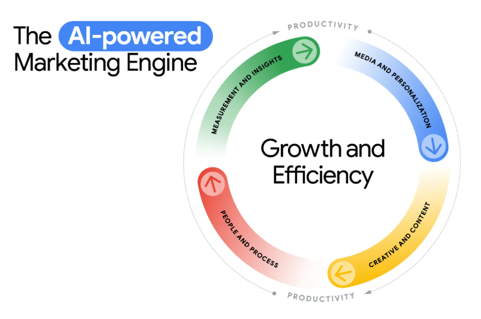To Navigate AI Turbulence, CMOs Can Apply The Flywheel Model via @sejournal, @gregjarboe
AI won’t replace CMOs, but those who use it effectively will lead the future. Learn the key strategies shaping marketing’s next era. The post To Navigate AI Turbulence, CMOs Can Apply The Flywheel Model appeared first on Search Engine...

Right now, as technology changes daily, chief marketing officers face exceptional levels of change and uncertainty. But it’s not for the first time (or the last).
During the COVID-19 pandemic, nearly two-thirds of CMOs in Fortune 500 companies overcame the extraordinary challenge of navigating change and uncertainty.
This resulted in 65% of CMOs who exited their roles after an average tenure of 4.3 years “being promoted to more senior roles” or “making lateral moves to other attractive CMO positions.”
However, what was a pandemic obstacle course has been followed by an AI Olympic steeplechase.
To navigate these turbulent times, CMOs should consider analyzing marketing research and applying digital trends to:
Discover consumer insights for effective marketing in a dynamic market. Unlock exceptional marketing results and increase return on investment (ROI) with the power of AI. Reach customers across search, video, social, and shopping platforms. Drive progress in marketing by championing the latest innovations and ideas. Transform their data into a tool for building a lasting business advantage.To lead their teams, CMOs could also apply the flywheel model, a customer-centric approach to business growth.
Adding AI To The Traditional Flywheel
Recently, based on a survey of 2,000 global marketers, Think With Google wrote:
“The traditional flywheel has always existed in marketing. Now, leaders are adding AI to multiply its momentum.”
 Screenshot from Think With Google, April 2025
Screenshot from Think With Google, April 2025
The article provides CMOs with a framework, built on four interconnected pillars:
Measurement and insights. Media and personalization. Creativity and content. People and process.This framework outlines how AI is amplifying the traditional marketing flywheel.
Measurement And Insights
The first pillar, stresses the importance of aligning key performance indicators (KPIs) with business performance metrics like profit and ROI.
Implementing modern, AI-powered measurement tools is crucial for accurate data and insights while respecting privacy.
A foundation of well-defined KPIs, historical data, and first-party data enables outcome-based planning, where AI predicts and improves campaign performance, optimizing budget allocation.
The future involves an AI-powered Marketing Engine for continuous, real-time optimization.
Media And Personalization
The second pillar, focuses on AI’s role in delivering the right ad to the right person at the right time.
Leading marketers scale successful AI-powered campaigns, shifting budgets for maximum ROI and flexibility.
AI identifies engaged, high-value audiences across channels, revealing valuable consumer behavior insights.
The ultimate stage is AI-powered media transformation, where an AI engine autonomously creates and refines media plans in real time based on continuous measurement.
Creativity And Content
The third pillar, explores how generative AI aids in brainstorming impactful ideas to help develop innovative content.
AI identifies and amplifies top-performing assets, and AI-powered “creative studios” accelerate time-to-market.
AI also enables pre-launch testing and optimization, bringing the goal of real-time, personalized creative delivery closer to reality.
People And Process
The fourth pillar, emphasizes collaboration, extending to the C-suite.
Sharing prioritized AI opportunities early is vital. Transformative leaders restructure organizations to fully leverage the AI engine.
Scaling AI success requires investing in AI talent to develop new operational methods, which are then formalized and disseminated.
Leading marketers design improved workflows and assess AI impact, recognizing that holistic organizational transformation is needed.
The article concludes that these four interdependent pathways merge to create the AI-powered Marketing Engine, amplifying the traditional marketing flywheel.
Analyzing Market Research And Applying Audience Research
CMOs will quickly notice that “The AI-powered Marketing Engine” framework can help to overcome four of the five obstacles that I mentioned above:
Measurement and insights can help transform their data into a tool for building a lasting business advantage. Media and personalization can help to reach customers across search, video, social, and shopping platforms. Creativity and content can help unlock exceptional marketing results and increase ROI. People and process can help to drive progress in marketing by championing the latest innovations and ideas.And CMOs will immediately wonder: Why can’t the AI-powered Marketing Engine help our analysts discover consumer insights for effective marketing in a dynamic market?
That’s the right question to ask, and there are two probable answers.
The first was provided by Avinash Kaushik in 2014, when he asked, “Is your company creating reporting squirrels or analysis ninjas?”
In any organization, investments in data generate two distinct types of work: Reporting Squirrel work and Analysis Ninja work. While both are important, only one directly contributes to improving the company’s financial performance.
Reporting Squirrels primarily focus on data production, spending most of their time creating reports for various stakeholders.
Their responsibilities include data extraction, query writing, fulfilling ad-hoc requests, scheduling data outputs, and coordinating with IT teams for data acquisition.
Conversely, Analysis Ninjas dedicate their time to analyzing data and generating actionable insights, which are typically communicated in clear, plain language.
Their work involves tasks such as data retrieval, segmentation, in-depth exploration, modeling, creating unique datasets, answering business questions, and defining data requirements for Reporting Squirrels and IT teams.
It’s important to note that Fortune 500 companies don’t typically hire individuals with the titles “Reporting Squirrel” and “Analysis Ninja.” Instead, they employ analysts or data scientists.
However, CMOs need to ask if these professionals are primarily focused on data output rather than providing actionable recommendations.
The second probable answer was in my recent article, where I mentioned, “GA4 gives us less than a third of the data we need to know about user acquisition: The initial stage of building business awareness and acquiring user interest.”
I added, “Somehow, we’ve missed what GA4 can’t – or doesn’t – tell us about the Zero Moment of Truth (ZMOT): the moment in the purchase process when the consumer or business buyer researches a product or service prior to visiting your website.”
So, if CMOs realize that they don’t have a clue about where the lion’s share of their customers discovered their brands or products before visiting their website, then what should they do?
They have two options: Get audience research and conduct market research.
Audience research and market research are distinct but complementary approaches to understanding a business environment.
Audience Research
Audience research focuses on the individual, delving into the needs, preferences, behaviors, and language of the target audience.
This micro-level perspective is achieved through direct engagement with the audience via interviews, surveys, focus groups, social media analysis, and by leveraging existing customer data like customer relationship management (CRM) and support logs.
Market Research
In contrast, market research takes a broader, macroeconomic view, examining the overall landscape.
It involves analyzing industry trends, competitor activities, economic data, and trade publications to assess the viability of products or services.
Think of market research as providing the map, indicating where to go, and audience research as the compass, guiding you on the best path to get there. Therefore, both types of research play crucial roles.
AI Won’t Take Your Job. Somebody Using AI Will
CMOs remember what economist Richard Baldwin said at the 2023 World Economic Forum’s Growth Summit: “AI won’t take your job. It’s somebody using AI that will.”
They understand that their Fortune 500 company expects them to successfully navigate the complexities of the AI era and achieve sustainable growth.
To do that, they must embrace AI-powered tools and frameworks while prioritizing a deep understanding of their audience through dedicated research efforts.
By integrating these approaches, CMOs can transform data into actionable insights, optimize marketing strategies, and ultimately, build a lasting competitive advantage in an increasingly dynamic market.
More Resources:
Leading A Data-Driven Content Marketing Journey With Vitor Peçanha A New Era Of SEO: Leveraging YouTube, LinkedIn, And Cross-Channel Strategies For Success 5 Key Enterprise SEO Priorities CMOs Need To Get RightFeatured Image: R.bussarin/Shutterstock

 Tekef
Tekef 








![Cracking the SEO Code: Regain Control of Search Visibility in the Age of AI [Webinar] via @sejournal, @hethr_campbell](https://www.searchenginejournal.com/wp-content/uploads/2025/05/featured-73.png)










![The 2026 AI Search Benchmark Every SEO Leader Needs [Webinar] via @sejournal, @lorenbaker](https://www.searchenginejournal.com/wp-content/uploads/2025/11/1-259.png)










